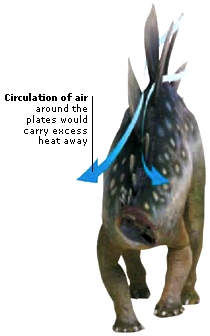DK Science: Body Temperature
Scientists cannot agree whether dinosaurs were coldblooded or warm-blooded. Cold-blooded animals, such as reptiles, become hot or cold, depending on the temperature of their environment. Warm-blooded animals, such as birds, have a regulation system that keeps the body temperature constant. A warmblooded animal needs to eat ten times as much food as a cold-blooded animal, just to fuel this system. It seems likely that giant herbivores, such as sauropods, could not have eaten enough to support such a system, and were cold-blooded. The carnivorous, active theropods, however, may have been warm-blooded.
Stegosaurus was one of the plated dinosaurs, with a series of bony plates up along its back. When it was discovered, in the 1870s, scientists assumed the plates were covered in horn and used for defence. Then, a century later, tracks of blood vessels were found in fossils of the plates. This gave rise to the idea that the plates may actually have been covered in skin, not horn, and used for temperature regulation instead of defence.
A lizard shows the behaviour typical of a cold-blooded animal. It has no internal mechanism to regulate its body temperature. When the environment turns cold, the lizard becomes cold and inactive. When the environment heats up, the lizard warms up too, and becomes active. It is capable of great bursts of speed, but it has to spend much of its time either basking in the sun or hiding in the shade.
If the plates of Stegosaurus were used for temperature regulation, they might have worked a little like solar panels. If the animal was feeling cold, it could turn so that the broad sides of its plates, with their large surface area, faced the sun to absorb its heat. If it wanted to cool down, the animal would turn its plates away from the sun. It might also turn to find a position in the wind so moving air would circulate around the plates and cool them.
Different animals function best at different body temperatures. Active, warm-blooded animals tend to have higher ideal body temperatures than slow, cold-blooded types. The ideal body temperature varies between animal types, with warm-blooded and coldblooded animals at either end of a gradual scale. It may be that dinosaurs ranged along a similar scale, with big plant-eaters, like sauropod’s functioning rather like cold-blooded reptiles, and active theropods at the higher end of the scale, with birds. Other dinosaurs may have ranged between these two extremes.
For decades scientists have argued over whether dinosaurs were warm-blooded or cold-blooded. Proof was hard to find, one way or another. Then, at the turn of this century, the beautifully preserved fossil of a chicken-sized theropod was found in China. The detailed fossil showed that the animal was covered in fine feathers. Only warm-blooded animals would need an insulating covering such as this. For many scientists, the discovery was the evidence they had been looking for. It showed that the small theropods, at least, were warm-blooded and had an active lifestyle. As yet, this feathered dromaeosaur has not been given a scientific name, and is only referred to as the “fuzzy raptor”. The discovery of this fossil also seems to support the theory that birds evolved from meat-eating dinosaurs
To order this book direct from the publisher, visit DK's website.


